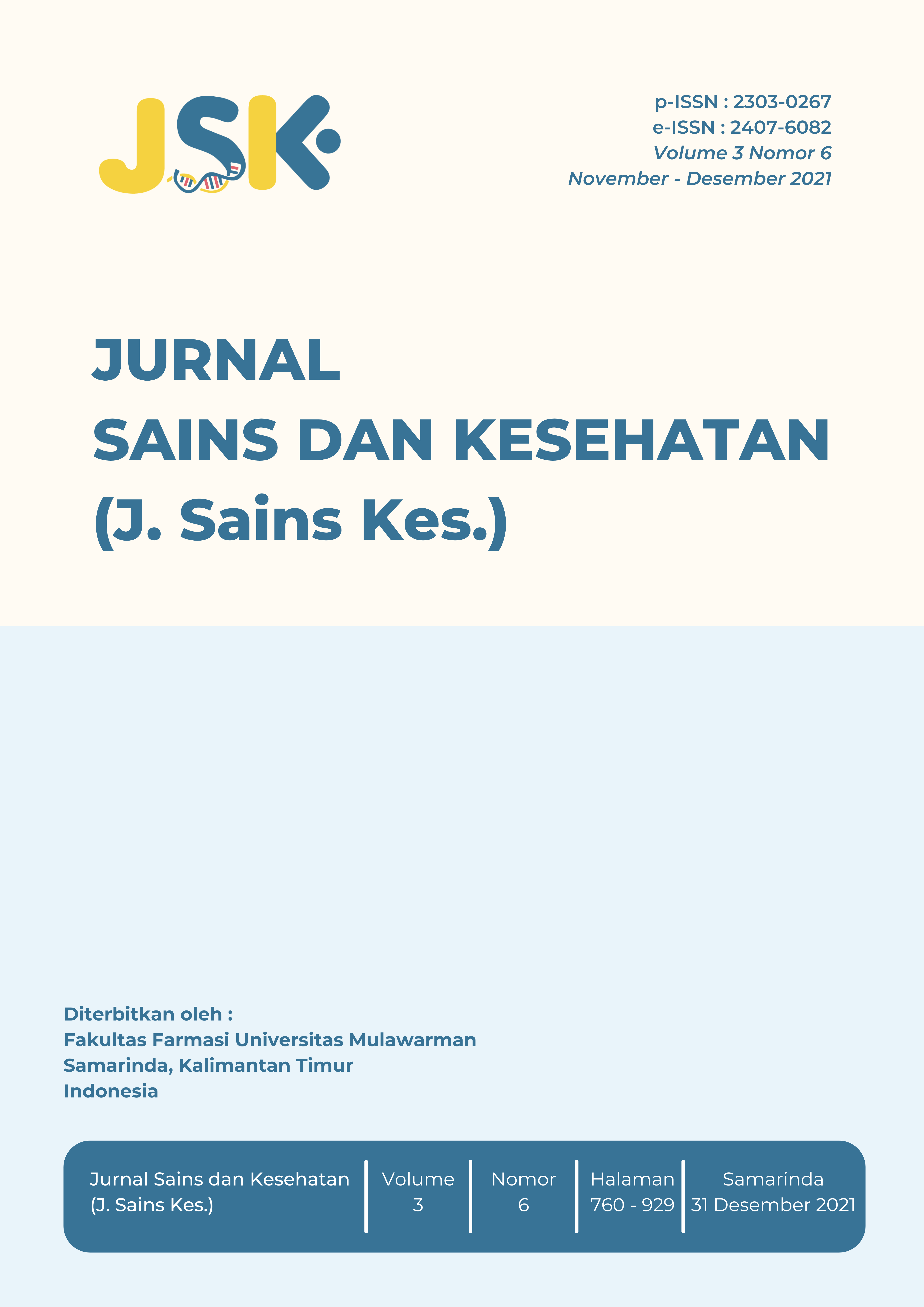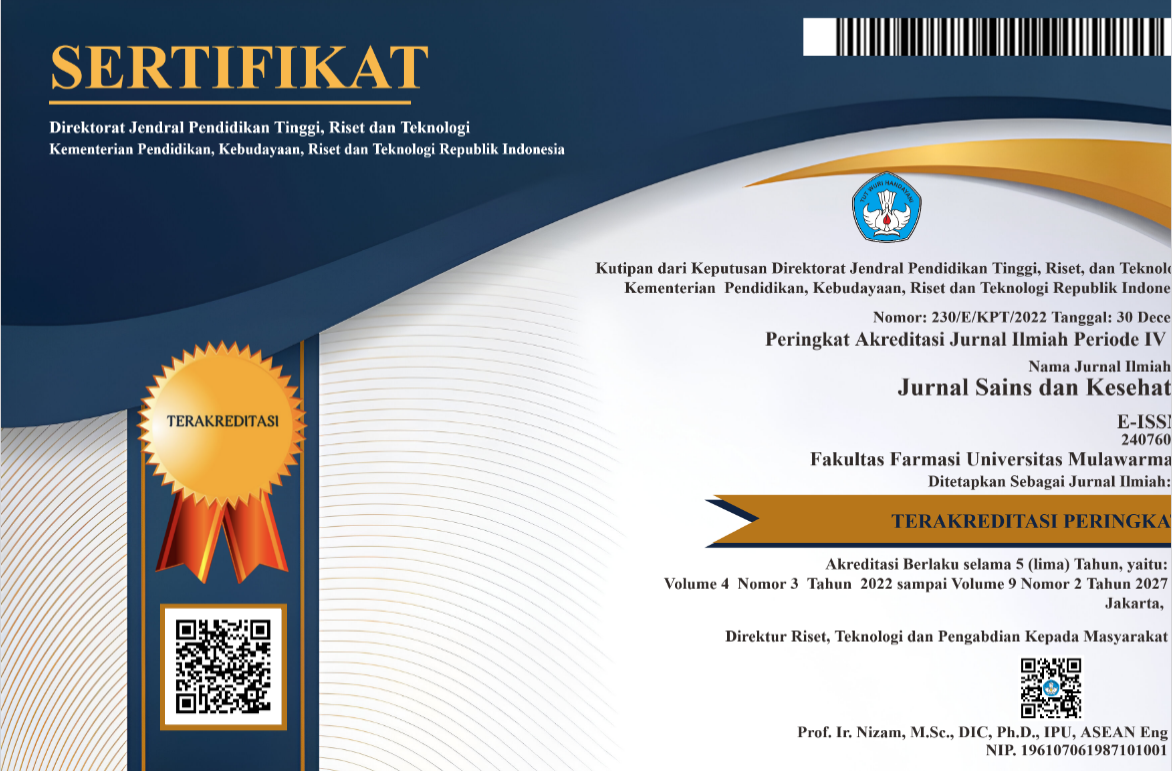Review: Pengaruh Faktor Risiko Terhadap Induksi Persalinan
Keywords:
induksi persalinan, usia maternal, jumlah paritas, indeks massa tubuh, skor BishopAbstract
References
1. Goel K, Gedam J, Rajput D, Bhalerao M. Induction of Labor: A Review. Indian J ClinPract. 2014;24(11):1057–64.
2. Al-Shaikh GK, Wahabi HA, Fayed AA, Esmaeil SA, Al-Malki GA. Factors associated with successful induction of labor. Saudi Med J. 2012;33(3):298–303.
3. WHO. WHO recommendations: Induction of labour at or beyond term [Internet]. WHO recommendations: Induction of labour at or beyond term. 2018. Available from: http://www.ncbi.nlm.nih.gov/pubmed/30629393
4. Vogel JP, Souza JP, Gülmezoglu AM. Patterns and Outcomes of Induction of Labour in Africa and Asia: A Secondary Analysis of the WHO Global Survey on Maternal and
Neonatal Health. PLoS One. 2013;8(6).
5. Coates D, Homer C, Wilson A, Deady L, Mason E, Foureur M, et al. Induction of labour indications and timing: A systematic analysis of clinical guidelines. Women and Birth [Internet]. 2019;
6. Anggriani DD, Herawati L, Ernawati E. Parity as failure determinants of labor induction in Bangka Belitung. Maj Obstet Ginekol. 2016;24(3):79.
7. Bassetty KC, Ahmed RD. Failed induction of labor (IOL): an overview regarding obstetric outcome and its significance in a health resource poor setting over a period of 11 months. Int J Reprod Contraception, Obstet Gynecol. 2017;6(8):3646.
8. Khan NB, Ahmed I, Malik A, Sheikh L. Factors associated with failed induction of labour in a secondary care hospital. J Pak Med Assoc. 2012;62(1):6–10.
9. Frederiks F, Lee S, Dekker G. Risk factors for failed induction in nulliparous women. J Matern Neonatal Med. 2012;25(12):2479–87.
10. Lockwood C, Oh EG. Systematic reviews?: Guidelines , tools and checklists for authors. Nurs Heal Sci. 2017;273–7.
11. Mccoy J, Downes KL, Srinivas SK, Levine LD, Mccoy J, Downes KL, et al. Postdates induction with an unfavorable cervix and risk of cesarean Postdates induction with an unfavorable cervix and risk of cesarean Ã. J Matern Neonatal Med [Internet]. 2018;0(0):1–5
12. Ronzoni S, Rosen H, Farine D, Maxwell C. Maternal Obesity Class as a Predictor of Induction Failure?: A Practical Risk Assessment Tool. Am J Perinatol. 2015;1(212):1298–304.
13. Quinones JN, Kwakye-ackah G, Burger A, Kainz G, Vega GD La. Induction of Labor in Women of Advanced Maternal Age. Poster Present Soc Matern Fetal Med 37th Annu Pregnancy Meet. 2017;
14. Levine LD, Downes KL, Parry S, Elovitz MA, Sammel MD, Srinivas SK. A validated calculator to estimate risk of cesarean after an induction of labor with an unfavorable cervix. Am J Obstet Gynecol [Internet]. 2018;218(2):254.e1-254.e7.
15. Jochum F, Ray C Le, Blanc-petitjean P, Langer B. Externally Validated Score to Predict Cesarean Delivery After Labor Induction With Cervical Ripening. Am Coll Obstet Gynecol. 2019;134(3):502–10.
16. Mariani LL, Mancarella M, Fuso L, Novara L, Menato G, Biglia N. Predictors of response after a second attempt of pharmacological labor induction?: a retrospective study. Arch Gynecol Obstet [Internet]. 2020;(0123456789).
17. Nwabuobi C, Gowda N, Schmitz J, Wood N, Pargas A, Bagiardi L, et al. Risk factors for Cesarean delivery in pregnancy with small-for-gestational-age fetus undergoing induction of labor. Ultrasound Obstet Gynecol. 2020;55(August 2019):799–805.
18. Teefey CP, Reforma L, Koelper NC, Sammel MD, Srinivas SK, Levine LD, et al. Risk Factors Associated With Cesarean Delivery After Induction of Labor in Women With Class III Obesity. Am Coll Obstet Gynecol. 2020;135(3):542–9.
19. Highley LL, Previs RA, Dotters-katz SK, Brancazio LR, Grotegut CA. Cesarean delivery among women with prolonged labor induction. J Perinat Med. 2015;
20. Ellis JA, Brown CM, Barger B, Carlson NS. Influence of Maternal Obesity on Labor Induction: A Systematic Review and Meta-Analysis. J Midwifery Women’s Heal. 2019;64(1):55–67.
21. Hurissa BF, Geta M, Belachew T. Prevalence of Failed Induction of Labor and Associated Factors Among Women Delivered in Hawassa Public Health Facilities, Ethiopia, 2015. J Womens Heal Care. 2015;04(05).
22. Kerbage Y, Senat M V, Drumez E, Subtil D, Vayssiere C, Deruelle P. Risk factors for failed induction of labor among pregnant women with Class III obesity. Acta Obstet Gynecol Scand. 2020;(November 2019):637–43.
23. Hadar E, Hiersch L, Ashwal E, Chen R, Wiznitzer A, Gabbay-Benziv R. Induction of labor in elderly nulliparous women. J Matern Neonatal Med [Internet]. 2016;30(18):2146–50.
24. Dunn L, Kumar S, Beckmann M. Maternal age is a risk factor for caesarean section following induction of labour. Aust New Zeal J Obstet Gynaecol. 2017;1–6.
25. Crankshaw DJ, Brien YMO, Crosby DA, Morrison JJ. Maternal Age and Contractility of Human Myometrium in Pregnancy. 2015;1–7.
26. Feghali M, Timofeev J, Huang C, Driggers R, Miodovnik M, Landy HJ, et al. Preterm Induction of Labor: Predictors of Vaginal Delivery and Labor Curves. Am J Obstet Gynecol [Internet]. 2015;
27. Dammer U, Bogner R, Weiss C, Faschingbauer F, Pretscher J, Beckmann MW, et al. Influence of body mass index on induction of labor?: A historical cohort study. J Obstet Gynaecol Res. 2018;1–11.
28. Gibson KS, Waters TP. Measures of success: Prediction of successful labor induction. Semin Perinatol [Internet]. 2015;39(6):475–82.
29. O’Brien CM, Thomas G, Newton JM, Reese J. In vivo Raman spectroscopy for biochemical monitoring of the cervix throughout pregnancy. Am J Obstet Gynecol [Internet]. 2018
30. Ryan GA, Nicholson SM, Crankshaw DJ, Ryan GA. Maternal parity and functional contractility of human myometrium in vitro in the third trimester of pregnancy. J Perinatol [Internet]. 2019;439–44.
31. Maged AM, El AM, Heba S, Doaa MM, Ayman SB, Mohammad H, et al. Effect of maternal obesity on labor induction in postdate pregnancy. Arch Gynecol Obstet [Internet]. 2018;(0123456789).
32. Khazardoost S, Ghotbizadeh F, Latifi S, Tahani M, Ali M. The Predictive Value of Trans-Vaginal Ultrasound Measurements Compared with Bishop Score in Determining Successful Induction of Labor. J Obstet Gynecol Cancer Res. 2016;1(2):1–7.
33. Prendergast C. Maternal phenotype?: how do age , obesity and diabetes affect myometrial function? Curr Opin Psychol [Internet]. 2020;13:108–16.
34. Lassiter JR, Holliday N, Lewis DF, Mulekar M, Brocato B, Lassiter JR, et al. Induction of labor with an unfavorable cervix?: how does BMI affect success?? Induction of labor with an unfavorable cervix?: how does BMI affect success?? z. J Matern Neonatal Med. 2015;7058(January 2016).
35. Yousuf F, Naru T, Sheikh S. Effect of body mass index on outcome of labour induction. J Pak Med Assoc. 2016;66(5):598–601.
36. Roloff K, Peng S, Sanchez-Ramos L, Valenzuela GJ. Cumulative oxytocin dose during induction of labor according to maternal body mass index. Int J Gynecol Obstet. 2015;131(1):54–8.
37. Chaemsaithong P, Kwan AHW, Tse WT, Lim WT, Chan WWY, Chong KC, et al. Factors that affect ultrasound-determined labor progress in women undergoing induction of labor. Am J Obstet Gynecol [Internet]. 2019;220(6):592.e1-592.e15.
38. TITILAYO R-OS. PREDICTING OUTCOME OF LABOUR INDUCTION USING SONOGRAPHIC CERVICAL LENGTH AND BISHOP SCORE AT UNIVERSITY OF ILORIN TEACHING HOSPITAL. 2017.
39. Kaoian V, Luangdansakul W, Wacharasint P. Transvaginal sonographic cervical length versus bishop score in labor induction to predict the risk of cesarean delivery: A comparison study. J Med Assoc Thail. 2018;101(2):157–61.
40. Anikwe CC, Okorochukwu BC, Uchendu E, Ikeoha CC. The Effect of Ultrasound- Measured Preinduction Cervical Length on Delivery Outcome in a Low-Resource Setting. 2020;2020(Cl).
41. Navve D, Orenstein N, Ribak R, Daykan Y. Is the Bishop-score significant in predicting the success of labor induction in multiparous women?? J Perinatol [Internet].2017;(June 2016):1–4.
Downloads
Published
Issue
Section
How to Cite
Most read articles by the same author(s)
- Syifa Fitria Anggraeny, Boyke Soebhali, Sulistiawati Sulistiawati, Poppy Desra S Nasution, Endang Sawitri, Gambaran Status Konsumsi Air Minum Pada Pasien Batu Saluran Kemih , Jurnal Sains dan Kesehatan: Vol. 3 No. 1 (2021): J. Sains Kes.
- Enggarita Widyahapsari, Hadi Irawiraman, Endang Sawitri, Tingkat Pengetahuan tentang Kanker Payudara dan Perilaku SADARI pada Mahasiswi Prodi Kedokteran Fakultas Kedokteran Universitas Mulawarman , Jurnal Sains dan Kesehatan: Vol. 3 No. 3 (2021): J. Sains Kes.
- Muhammad Fachrian Akbar, Agustina Rahayu Magdaleni, Hary Nugroho, Endang Sawitri, Arie Ibrahim, Pengaruh Irama Sirkadian Terhadap Memori Jangka Pendek pada Mahasiswa Fakultas Kedokteran Universitas Mulawarman , Jurnal Sains dan Kesehatan: Vol. 3 No. 5 (2021): J. Sains Kes.
- Ilham Akbar Choirul Umam, Hadi Irawirawan, Endang Sawitri, Hubungan Usia dengan Kadar Prostate Specific Antigen pada Penderita Benign Prostatic Hyperplasia di Laboratorium Patologi Anatomi RSUD Abdul Wahab Sjahranie Samarinda , Jurnal Sains dan Kesehatan: Vol. 2 No. 4 (2020): J. Sains Kes.
- Sofia Apriyanti, Endang Sawitri, Nur Khoma Fatmawati, Penggunaan Smartphone Berpengaruh Terhadap Gejala Computer Vision Syndrome , Jurnal Sains dan Kesehatan: Vol. 3 No. 5 (2021): J. Sains Kes.
- Hamdi Mayulu, Endang Sawitri, Irsan Tricahyadinata, The Impact of Covid-19 Pandemic on the Livestock Subsector , Jurnal Sains dan Kesehatan: Vol. 5 No. 2 (2023): J. Sains Kes.
- Endang Sawitri, Hermawati Rahman, Hadi Irawiraman, The Relationship Between Physical Activity and Stress Levels With The Menstrual Cycle in Female Students of The Faculty of Medicine, Mulawarman University , Jurnal Sains dan Kesehatan: Vol. 6 No. 3 (2025)
Similar Articles
- Florensya Gohao, Arwyn Weynand Nusawakan, Angkit Kinasih, Keterkaitan Antara Kejadian ISPA, Indeks Massa Tubuh (IMT), Dan Prestasi Akademis Pada Siswa Sekolah Dasar di Manokwari , Jurnal Sains dan Kesehatan: Vol. 3 No. 4 (2021): J. Sains Kes.
- Bayu Perkasa Rosari, Dyonesia Ary Harjanti, Riki Tenggara, Sem Samuel Surja, Ferbian Milas Siswanto, Chris Kusuma, Eveline Lee, Joseph Nicholas Limanto, Perbandingan Karakteristik Klinikopatologik Karsinoma Kolorektal antara Pasien Geriatri dan Non-Geriatri , Jurnal Sains dan Kesehatan: Vol. 6 No. 3 (2025)
- Caecilia Anggi Raharjo, Novia Fransiska Ngo, Annisa Muhyi, Hubungan Kejadian Skor Apgar Kurang dari 7 dengan Faktor Risiko Ibu dan Persalinan di RSUD Abdul Wahab Sjahranie Samarinda Tahun 2018-2019 , Jurnal Sains dan Kesehatan: Vol. 3 No. 2 (2021): J. Sains Kes.
- Ditya Ayu Natalia, Sugiyarto, Endang Darmawan, Efek Samping Hipoglikemi yang Dialami oleh Pasien Geriatri yang Berisiko Sindrom Metabolik , Jurnal Sains dan Kesehatan: Vol. 4 No. 4 (2022): J. Sains Kes.
- Deden Winda Suwandi, Josep Bahari, Anas Subarnas, Aktivitas Antiobesitas Ekstrak Etanol Daun Kemuning (Murraya paniculata (L.) Jack) pada Tikus Betina Galur Wistar , Jurnal Sains dan Kesehatan: Vol. 5 No. 3 (2023): J. Sains Kes.
- Rohmi Pawitra Sari, Denny Jeffry Rotinsulu, Evi Fitriany, Hubungan Indeks Massa Tubuh dan Lingkar Pinggang dengan Kualitas Tidur Mahasiswa Preklinik Program Studi Kedokteran, Fakultas Kedokteran Universitas Mulawarman , Jurnal Sains dan Kesehatan: Vol. 3 No. 3 (2021): J. Sains Kes.
- Fauziah Putri Chatamy, Nurul Hasanah, Hadi Irawiraman, Usia dan Paritas Tidak Berhubungan dengan Ekspresi Estrogen Reseptor (ER) dan Progesteron Reseptor (PR) pada Kanker Payudara Invasif No Special Type (NST) di RSUD Abdul Wahab Sjahranie Samarinda , Jurnal Sains dan Kesehatan: Vol. 4 No. 2 (2022): J. Sains Kes.
- Risna Agustina, Andreanus A. Soemardji, Efektivitas Akupunktur “GI” terhadap Pengobatan Stres pada Pasien di Klinik Akupunktur Sukamenak dan UPT Layanan Kesehatan Bumi Medika Ganesa ITB , Jurnal Sains dan Kesehatan: Vol. 1 No. 5 (2016): J. Sains Kes.
- Risna Agustina, Nurul Annisa, Wisnu Cahyo Prabowo , Potensi Interaksi Obat Resep Pasien Hipertensi di Salah Satu Rumah Sakit Pemerintah di Kota Samarinda , Jurnal Sains dan Kesehatan: Vol. 1 No. 4 (2015): J. Sains Kes.
- Gilang Juniar Azmi, Putri Qoonitah Dewi, Siti Yuditha Cahaya Anugerah, Sachnaz Desta Oktarina, Akbar Rizki, Muhammad Rizky Nurhambali, Analisis Faktor yang Memengaruhi Tingkat Diabetes Melitus pada Masyarakat di Kota/Kabupaten di Provinsi Jawa Timur Tahun 2018 , Jurnal Sains dan Kesehatan: Vol. 5 No. 5 (2023): J. Sains Kes.
You may also start an advanced similarity search for this article.




